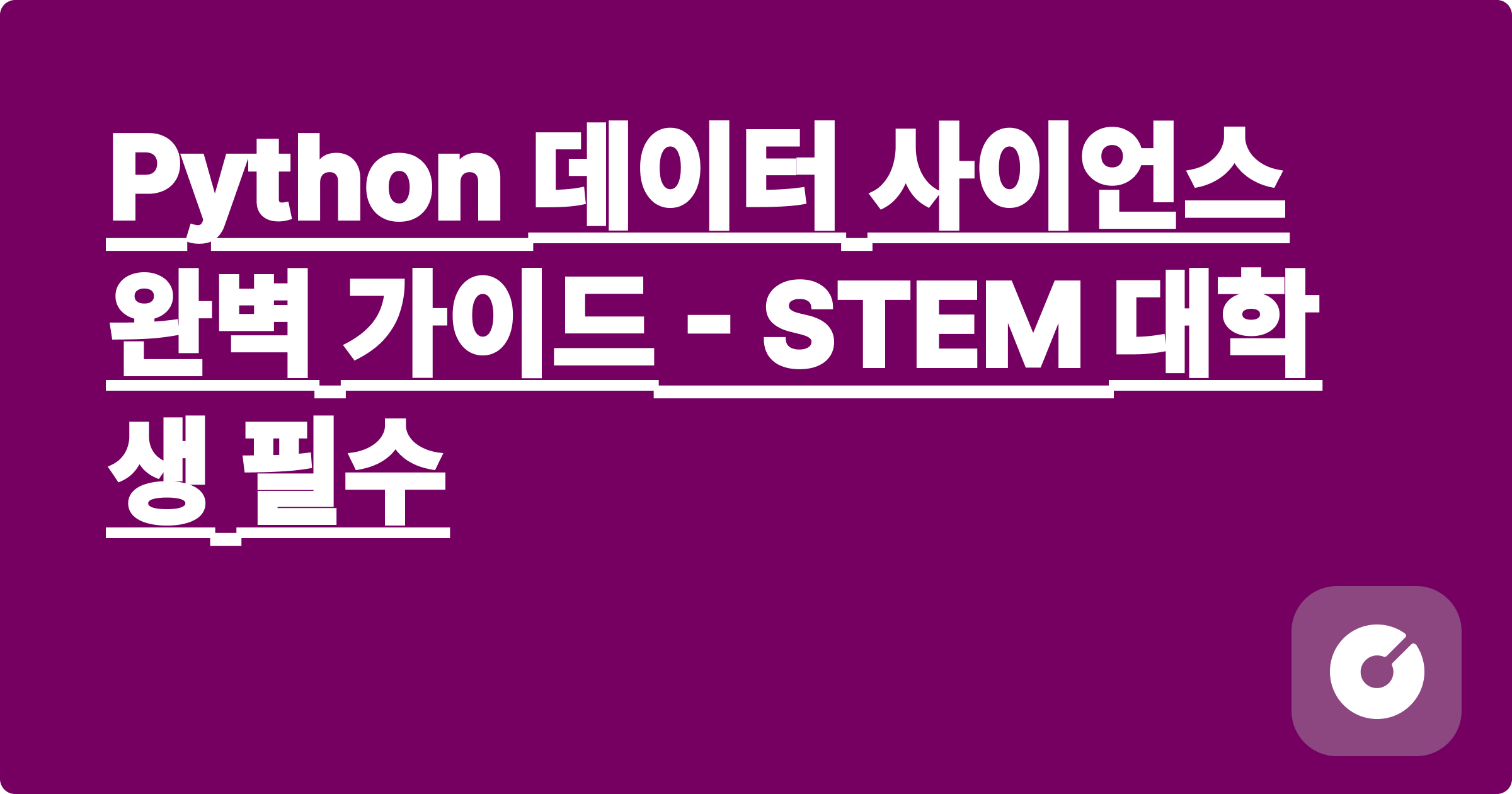# Python 데이터 사이언스 완벽 가이드 - STEM 대학생 필수
## 🎯 왜 데이터 사이언스를 배워야 할까?
현대 사회에서 데이터는 **새로운 석유**라고 불립니다. STEM 분야의 모든 영역에서 데이터 분석 능력은 필수가 되었고, Python은 이를 위한 가장 강력한 도구 중 하나입니다.
### 데이터 사이언스가 STEM 분야에 미치는 영향
- **공학**: 센서 데이터 분석, 시뮬레이션 결과 해석
- **의학**: 임상 데이터 분석, 바이오마커 발견
- **물리학**: 실험 데이터 분석, 모델 검증
- **화학**: 분자 구조 분석, 반응 예측
## 🐍 Python 데이터 사이언스 핵심 라이브러리
### 1. NumPy - 수치 계산의 기초
```python
import numpy as np
# 배열 생성과 기본 연산
data = np.array([1, 2, 3, 4, 5])
mean = np.mean(data)
std = np.std(data)
print(f"평균: {mean}, 표준편차: {std}")
```
### 2. Pandas - 데이터 조작의 강자
```python
import pandas as pd
# CSV 파일 읽기
df = pd.read_csv('data.csv')
# 기본 정보 확인
print(df.info())
print(df.describe())
# 데이터 필터링
filtered_data = df[df['score'] > 80]
```
### 3. Matplotlib & Seaborn - 시각화
```python
import matplotlib.pyplot as plt
import seaborn as sns
# 히스토그램
plt.figure(figsize=(10, 6))
plt.hist(data, bins=20, alpha=0.7)
plt.title('데이터 분포')
plt.show()
# 상관관계 히트맵
correlation_matrix = df.corr()
sns.heatmap(correlation_matrix, annot=True)
```
## 🚀 실전 프로젝트: 학습 성과 데이터 분석
### 프로젝트 목표
대학교 과목별 성적 데이터를 분석하여 학습 패턴을 발견하고 성과 예측 모델을 구축해보겠습니다.
### 단계 1: 데이터 수집 및 전처리
```python
import pandas as pd
import numpy as np
# 샘플 데이터 생성
np.random.seed(42)
students = 1000
subjects = ['Math', 'Physics', 'Chemistry', 'Biology', 'CS']
data = {
'student_id': range(1, students + 1),
'study_hours': np.random.normal(5, 2, students),
'attendance_rate': np.random.uniform(0.7, 1.0, students),
'previous_gpa': np.random.normal(3.0, 0.5, students)
}
for subject in subjects:
data[f'{subject}_score'] = (
data['study_hours'] * 8 +
data['attendance_rate'] * 20 +
data['previous_gpa'] * 15 +
np.random.normal(0, 5, students)
)
df = pd.DataFrame(data)
df = df.clip(lower=0, upper=100) # 점수를 0-100 범위로 제한
```
### 단계 2: 탐색적 데이터 분석 (EDA)
```python
# 기본 통계 정보
print(df.describe())
# 상관관계 분석
score_columns = [col for col in df.columns if 'score' in col]
correlation = df[['study_hours', 'attendance_rate', 'previous_gpa'] + score_columns].corr()
# 시각화
plt.figure(figsize=(12, 8))
sns.heatmap(correlation, annot=True, cmap='coolwarm', center=0)
plt.title('변수 간 상관관계')
plt.show()
```
### 단계 3: 머신러닝 모델 구축
```python
from sklearn.model_selection import train_test_split
from sklearn.linear_model import LinearRegression
from sklearn.metrics import mean_squared_error, r2_score
# 특성과 타겟 변수 분리
X = df[['study_hours', 'attendance_rate', 'previous_gpa']]
y = df['Math_score']
# 훈련/테스트 데이터 분할
X_train, X_test, y_train, y_test = train_test_split(X, y, test_size=0.2, random_state=42)
# 모델 훈련
model = LinearRegression()
model.fit(X_train, y_train)
# 예측 및 평가
y_pred = model.predict(X_test)
mse = mean_squared_error(y_test, y_pred)
r2 = r2_score(y_test, y_pred)
print(f"MSE: {mse:.2f}")
print(f"R² Score: {r2:.2f}")
```
## 📊 고급 데이터 분석 기법
### 1. 시계열 분석
```python
# 날짜별 성적 변화 분석
dates = pd.date_range('2024-01-01', periods=100, freq='D')
performance = np.random.normal(75, 10, 100) + np.sin(np.arange(100) * 0.1) * 5
ts_data = pd.DataFrame({
'date': dates,
'performance': performance
})
ts_data.set_index('date', inplace=True)
ts_data.plot(figsize=(12, 6))
plt.title('시간에 따른 학습 성과 변화')
plt.show()
```
### 2. 클러스터링
```python
from sklearn.cluster import KMeans
from sklearn.preprocessing import StandardScaler
# 데이터 표준화
scaler = StandardScaler()
scaled_features = scaler.fit_transform(X)
# K-means 클러스터링
kmeans = KMeans(n_clusters=3, random_state=42)
clusters = kmeans.fit_predict(scaled_features)
# 결과 시각화
plt.figure(figsize=(10, 8))
plt.scatter(X['study_hours'], X['attendance_rate'], c=clusters, cmap='viridis')
plt.xlabel('Study Hours')
plt.ylabel('Attendance Rate')
plt.title('학생 그룹 클러스터링')
plt.colorbar()
plt.show()
```
## 🔧 실무에서 사용하는 도구와 팁
### 1. Jupyter Notebook 활용법
- **셀 단위 실행**: 코드를 단계별로 테스트
- **마크다운 문서화**: 분석 과정을 문서로 기록
- **매직 커맨드**: %time, %matplotlib inline 등 활용
### 2. 데이터 시각화 베스트 프랙티스
```python
# 전문적인 그래프 스타일
plt.style.use('seaborn-v0_8')
fig, axes = plt.subplots(2, 2, figsize=(15, 10))
# 여러 차트를 한 번에
df['Math_score'].hist(ax=axes[0,0], bins=30)
axes[0,0].set_title('수학 성적 분포')
df.boxplot(column='Physics_score', by='attendance_rate', ax=axes[0,1])
axes[0,1].set_title('출석률별 물리 성적')
plt.tight_layout()
plt.show()
```
### 3. 성능 최적화 팁
```python
# 대용량 데이터 처리
chunk_size = 10000
for chunk in pd.read_csv('large_file.csv', chunksize=chunk_size):
# 청크별 처리
processed_chunk = chunk.groupby('category').mean()
# 결과 저장
```
## 📚 추천 학습 리소스
### 온라인 강의
1. **Coursera - Applied Data Science with Python** (University of Michigan)
2. **edX - Introduction to Data Science** (MIT)
3. **Kaggle Learn** - 무료 마이크로 코스
### 실습 플랫폼
- **Kaggle**: 실제 데이터셋과 경진대회
- **Google Colab**: 무료 GPU/TPU 환경
- **GitHub**: 오픈소스 프로젝트 참여
### 추천 도서
- "Python for Data Analysis" by Wes McKinney
- "Hands-On Machine Learning" by Aurélien Géron
- "The Elements of Statistical Learning" by Hastie, Tibshirani, Friedman
## 🎯 다음 단계: 전문성 심화
### 1. 특화 분야 선택
- **머신러닝**: scikit-learn, TensorFlow, PyTorch
- **빅데이터**: Spark, Hadoop 생태계
- **웹 스크래핑**: BeautifulSoup, Scrapy
- **자연어 처리**: NLTK, spaCy, transformers
### 2. 포트폴리오 프로젝트 아이디어
- 캠퍼스 에너지 사용량 예측
- SNS 데이터를 활용한 트렌드 분석
- 의료 데이터 기반 질병 예측 모델
- 금융 데이터 분석 및 투자 전략
### 3. 커리어 연결
- **데이터 사이언티스트**: 비즈니스 문제 해결
- **머신러닝 엔지니어**: 모델 개발 및 배포
- **데이터 분석가**: 인사이트 도출 및 리포팅
- **연구원**: 학술 연구에 데이터 과학 적용
## 🚀 마무리
Python 데이터 사이언스는 STEM 분야에서 **필수 스킬**이 되었습니다. 단순히 도구를 배우는 것을 넘어서, **데이터로 사고하는 능력**을 기르는 것이 중요합니다.
### 성공을 위한 핵심 포인트
1. **꾸준한 실습**: 매일 조금씩이라도 코딩하기
2. **실제 데이터 활용**: 교육용 데이터셋을 넘어선 실전 경험
3. **커뮤니티 참여**: GitHub, Stack Overflow, Reddit 등에서 활발한 활동
4. **지속적 학습**: 빠르게 변화하는 기술 트렌드 따라가기
오늘부터 당신의 데이터 사이언스 여정을 시작해보세요. 첫 번째 프로젝트로 자신의 학습 데이터를 분석해보는 것은 어떨까요? 🎯
Related Articles
Explore these related topics to enhance your understanding:
